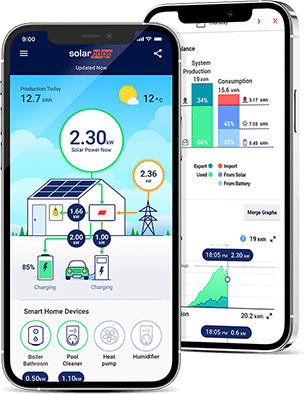Solar 2.0: How Smart Software is Paving the Way for the Next Solar Revolution
Until recently, solar energy systems had limited functionality. Solar panels convert sunlight into DC electricity while the solar inverter converts that energy into the AC electricity for use in our homes and manages the interaction with the power grid. Inverters have been limited to performing these specific tasks exclusively for the PV system they were integrated into, with no additional capabilities.
Over the past decade and a half, this has changed. Just as smartphones are now the central device by which we manage our lives, so too are today’s solar inverters that provide more sophisticated communication integration and control capabilities, expanding their role into becoming the smart energy manager of our homes. This not only includes converting solar energy into electricity, but also automatically managing devices like hot water heaters or EVs, or supporting solar batteries, and exporting energy to Virtual Power Plants, microgrids, while automatically managing household energy consumption. With this increased functionality, we began to understand the true potential of solar inverters as the ‘brains’ of the solar energy system.

With the mySolarEdge app, homeowners can monitor their solar PV system and control smart home devices on –the-go.
One Size No Longer Fits All
The home energy ecosystem is currently undergoing a major shift. Changing energy consumption patterns, increased electrification, fluctuating utility costs, and the evolving environment of energy distribution is reshaping the way energy is managed. As this becomes more complex, we need smarter software that prioritizes the homeowner’s preferences while ensuring they get the most out of their energy production, consumption, and storage.
To add to this challenge, balancing the supply and demand of electricity in many regions has become increasingly difficult for utility companies. As seen in California, the abundance of solar energy creates a massive daily spike in solar production, straining the conventional power grid. The second major strain to the grid ensues with the peak surge in electricity demand that occurs in the evening when the sun goes down. This makes it harder for grid operators to balance the extreme swings.
To mitigate this imbalance, utility companies have started introducing Time-of-Use (TOU) and Dynamic Rate plans, where rates are usually higher during peak demand times (such as in the early evening), and lower at off-peak times. The new NEM (Net Energy Metering) 3.0 regulations include TOU plans with specific rates that change each time of the day, month and year, and even include a separate set of export rates to discourage solar export to the grid during peak export hours.

To make this process even more complicated, home electrification is increasing as electrical consumption patterns are changing. More electric vehicles, heat pumps, and people working from home, coupled with electricity price hikes and changing time-of-use rates signify that we need to think more intelligently about how to best consume our energy. To be effective, this requires energy consumers to be more actively engaged in managing their home’s energy – a challenge that might seem to many consumers quite complex.

The Solution: Seamless Integration Between Hardware and Decision-Making Software
If the first revolution in solar energy made the technology available to more people in more places, the next era will be about placing the individual user’s energy needs at the forefront of every decision made by the solar inverter. This can only be done through intuitive, intelligent software. By crafting an ecosystem that seamlessly connects the solar energy system with the utility grid, electric vehicle charger, heating system and household appliances, users can have a completely personalized and consistent experience that optimizes their solar energy according to their needs.
So, what needs to happen in order to continue this advancement? First of all, energy management software should be able to make hundreds of decisions automatically on a daily basis, by analyzing site PV production, weather patterns, local electricity rates, price optimization, demand response, individual household behaviour, and other factors.
But at the heart of this approach lies a user-centric philosophy . Do homeowners want to optimize their PV production for profit, convenience, or decarbonization?
Imagine living in a world where your solar energy system app acts as a personal energy AI assistant. Not only does it automatically know where to direct the solar energy based on your consumption habits, but it utilizes the data points mentioned above to make the most optimal energy decisions for your household’s benefit. It estimates approximately how much energy your PV system will produce and consume each day, while considering the cost of importing and exporting to the grid during the different hours of the day according to the TOU and available net metering rates.
For example, maybe you now work from home more often. Consequently, your electricity bill has been higher this summer due to all that electricity you used during the day for air conditioning and other appliances. Your PV system can automatically know when to direct solar energy to your a/c during peak rate hours, or pull from the utility grid and direct solar energy to the battery during lower-rate hours. If a major storm is coming, the system can automatically charge the battery for backup in case of an electricity outage. But it can also understand that at certain hours, you may save more by exporting PV to the grid.
Imagine arriving to work in the morning and plugging your EV charger in at the office’s solar carport. Maybe the electricity rates are higher at 9 AM, so the software will automatically know to wait until noon to start charging the car, when the electricity rates are lower.
This goes way beyond the mere functionality of a traditional solar PV system, as it makes the most out of your investment based on your individual lifestyle and the community you live in. As we continue to shape the future of smart solar energy, customer-centric software will revolutionize the dynamics between us, the grid, and renewable energy.



